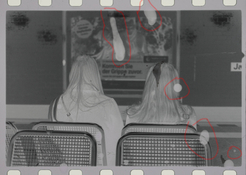cvansas
Member
- Joined
- Jan 17, 2011
- Messages
- 11
- Format
- Medium Format
Hi there,
Lately im getting some strange spots on my BW film quite often it happens on films of different brands, ilford, bergger ect. I changed the developer and fixer and the problem still exists. Using a rotary jobo ATL system.
The film seems to be undeveloped around those spots I have the feeling that the spots sometimes arise hrs after which might suggest unfinished fixing. I reuse my kodak fixer 2 times.
Anyone an idea what could cause this? I try to prevent losing all my film
Lately im getting some strange spots on my BW film quite often it happens on films of different brands, ilford, bergger ect. I changed the developer and fixer and the problem still exists. Using a rotary jobo ATL system.
The film seems to be undeveloped around those spots I have the feeling that the spots sometimes arise hrs after which might suggest unfinished fixing. I reuse my kodak fixer 2 times.
Anyone an idea what could cause this? I try to prevent losing all my film







 There are traces of the image inside the spots so it looks to me like something has spilt on the negative and is holding back development in the early stages when the image forms quickly, maybe it's simply a splatter of water off an undried reel? With a rotary tank the speed of the development process is generally faster than a Paterson tank leaving less time for the splattered area to catch up with the rest of the negative. Anyway just a thought.
There are traces of the image inside the spots so it looks to me like something has spilt on the negative and is holding back development in the early stages when the image forms quickly, maybe it's simply a splatter of water off an undried reel? With a rotary tank the speed of the development process is generally faster than a Paterson tank leaving less time for the splattered area to catch up with the rest of the negative. Anyway just a thought.
